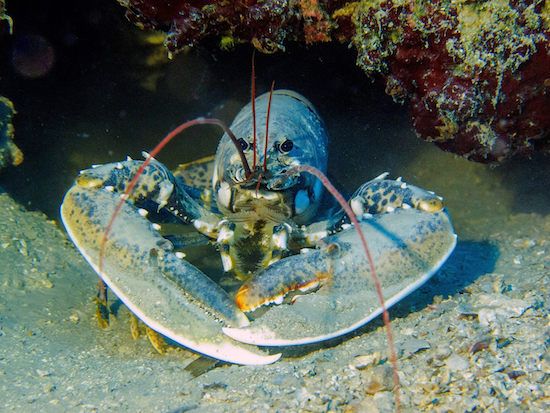| Crustaeceans and Marine Arthropods |
| Horsehoe Crab |
| Christmas Island Crab |
| Coconut Crab |
| Hermit Crab |
| Fiddler Crab |
| Alaskan King Crab |
| American Lobster |
| Rusty Crayfish |
Image Credit: https://pixabay.com/users/tauchteufel-2599128/ |
The American lobster, scientifically known as Homarus americanus, is a maritime delicacy celebrated for its succulent meat and impressive size. Thriving along the Atlantic coast of North America, from Newfoundland to North Carolina, the American lobster has played a significant role in coastal cuisine and cultural heritage.
Majestic Appearance and Biology: A Crustacean Marvel
The American lobster is characterized by its robust exoskeleton, distinctive claws, and an impressive span that can exceed two feet. Renowned for its striking coloration, with hues ranging from deep blue to greenish-brown, the lobster's appearance is both captivating and iconic. The species exhibits remarkable biological traits, including its ability to regenerate limbs and adapt to various environmental conditions.
Habitat and Range: From Rocky Shores to Deep Ocean Floors
American lobsters inhabit diverse marine environments, from rocky intertidal zones to the continental shelf. They prefer hiding in crevices and burrows along the ocean floor, seeking shelter from predators and environmental changes. Lobsters thrive in cold, oxygen-rich waters, and their range spans the North Atlantic, making them a vital component of the coastal ecosystems.
Culinary Tradition: From Trap to Table
The American lobster holds a central place in coastal culinary traditions, with lobster fishing and dining becoming cultural institutions. Harvested using lobster traps, the industry contributes significantly to the economies of coastal communities. Lobsters are celebrated for their tender, sweet meat, often enjoyed in various culinary forms, from traditional lobster boils to gourmet dishes served in fine dining establishments.
Life Cycle and Reproduction: A Complex Mating Dance
The American lobster undergoes a fascinating life cycle, starting as microscopic larvae that float in the ocean currents before transforming into juvenile lobsters. Mating involves a complex courtship dance, where male lobsters attract females with pheromones and engage in a ritualistic display. After mating, the female carries eggs beneath her abdomen until they hatch into larvae, marking the beginning of a new generation.
A Rare Variant
The rare blue lobster, a captivating anomaly in the world of crustaceans. This striking variation occurs due to a genetic mutation that causes the lobster to produce an excess of a particular protein, resulting in the distinct blue coloration of its shell. Blue lobsters are exceptionally rare, with estimates suggesting that only one in two million lobsters exhibits this mesmerizing hue. This extraordinary rarity has turned blue lobsters into sought-after curiosities, often garnering attention when accidentally caught by fishermen.
Sustainability Challenges: Conservation Concerns for Lobster Populations
Despite its culinary popularity, the American lobster faces sustainability challenges. Overfishing, habitat degradation, and the impacts of climate change pose threats to lobster populations. Conservation efforts, such as size limits, trap restrictions, and marine protected areas, aim to ensure the long-term health of lobster populations and preserve the ecological balance of coastal ecosystems.
Cultural Significance: Lobster as a Symbol of Coastal Identity
The American lobster holds cultural significance beyond its culinary appeal. It symbolizes coastal identity, a connection to maritime traditions, and the resilience of coastal communities. Lobster festivals, fishing competitions, and lobster boat races contribute to the rich tapestry of coastal heritage, celebrating the enduring relationship between communities and the sea.
